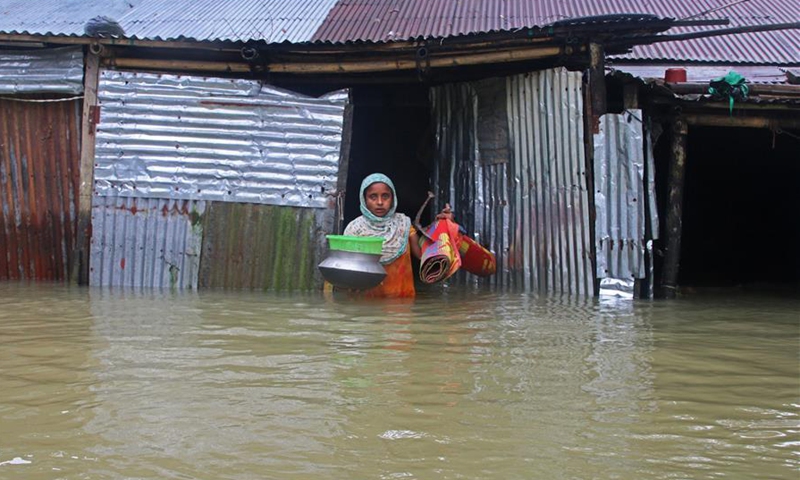Floods Join COVID-19 Impacting Health of the Affected People
What happens when a flood joins a
pandemic situation? Specifically, what happens when floods join a global
pandemic like COVID-19? Unfortunately, we have gotten the answer in the last few
months. The monsoon floods of the year 2020 have impacted Bangladesh with all
its might, which was already struggling to control the COVID-19 situation.
Impact
of the Floods:
Every year some parts of the country flood in monsoon season
but this year it stayed longer. The monsoon floods of this year have impacted 21
districts and 16 of them have been impacted moderately to severely. The overall
impact was on the Northern, North-Eastern region of Bangladesh. The highest peak of
the flooding was estimated at the Bahadurabad point with a 71% probability of
high flooding. The peak of the flood was anticipated to hit on the 18th
July 2020. As of 22nd July 2020, 102 Upazilla and 654 Unions have
been impacted by the flood affecting 3.3 million people and leaving 731,958
people waterlogged. 93 people died, mostly as a result of drowning. 41
children died due to drowning since 30th June 2020.
Disaster Management and Relief State MinisterEnamur Rahman
said that the flood had affected more or less 31 of the 64 districts across
Bangladesh. He quoted,’ The number of families affected by the flood stood at
865,800 and the total number of people over 39.75 lakhs’. He also said that it
might take longer than usual for flood water to recede from central districts,
sea tide may delay water draining out.
Flood
Affecting COVID-19 situation:
Floods of the year 2020 have an exacerbating effect on
COVID-19 pandemic situation. Disruptions of the economic and social activities are
high for Unions with a high displacement rate due to the flood. As per primary
data, 24% of Unions have more than 40% of people displaced are staying in makeshift
places and 93% of the Unions witnessed disruption in income-generating and
social activities. With those areas where the water level is high, people had
evacuated to the shelters. In this situation, the main preventive measure to stop
spreading COVID-19 which is washing hands regularly and frequently is quite
impossible. In shelters with so many people, washing facilities are also
compromised. Even social distancing is not possible for most of the affected
people. Due to damages to shelters, many are living together which increases
the risk of COVID-19 spreading.
Healthcare
of the Affected People:
Even in normal circumstance healthcare provided for the
rural areas are not enough. Now physical access to primary healthcare is
disrupted due to restricted mobility and due to inundation of flood and
COVID-19 pandemic. The survey shows that 73% of the affected Unions suffered
from disrupted healthcare services, increasing the risk of mortality and lack
of nutrition amid this situation. 75 Unions reported compromised nutrition
care, which may escalate the epidemic. Flood damage along with COVID-19 puts added
distress on vulnerable people like pregnant women, adolescent children,
children, elderly people, a person with disabilities, etc. Primary data shows that
healthcare services and antenatal and neonatal care services have been
disrupted in 251 and 215 Unions which is 75% and 64% Unions respectively.
This monsoon floods severely comprise the need for safe
drinking water and safe hygiene practices. Out of the affected Districts, 7
Districts are out of safe drinking water, 81,179 latrines and 73,343 tube-wells
are damaged and destroyed. 93% of the sanitation facility is disrupted.
Therefore, increasing the risk of water-borne disease, infection, and COVID-19
spread.
The Ministry of Disaster Management and Relief (MoDMR) The government of Bangladesh took all the possible precautions anticipating the
monsoon floods of the year 2020 to limit the loss of lives. The MoDMR
coordinated efforts with the relevant government and non-government
stakeholders. The early forecast mechanism (T-10 early action) had been
implemented by the Ministry. Because of that, the emergency response was
different from previous years which supported early preparedness and action
to support emergency life savings humanitarian assistance. To support
impacted communities the Government of Bangladesh had mobilized resources.
Source:
https://modmr.gov.bd/?fbclid=IwAR08WMCd0IbXSTr4nWXz6XJRMZdZhIuwWUiTh8sUofmq8Z_UmAqqAEiGuG0
Sumayea Samad Sneegdha
1st Batch, Department of Law and Land Administration
University of Rajshahi

Comments
Post a Comment